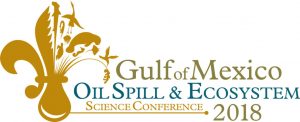Oil Spill Scientists, Responders, and GoMRI Community Gather in New Orleans for 2018 Gulf of Mexico Oil Spill and Ecosystem Science Conference
– MARCH 29, 2018
(From Winter 2018 Newsletter) The 2018 Gulf of Mexico Oil Spill and Ecosystem Science (GoMOSES) conference was held from February 5-8, 2018 at the Hyatt Regency in New Orleans, Louisiana. This year’s conference theme was Response, Restoration, and Resilience in the Gulf, and the goal was to continue efforts to bring together members of academia, industry, government agencies, and the response community to “explore how fundamental science can help restore and maintain Gulf ecosystem integrity, inform response strategies, and strengthen resilience.” In order to more fully address the conference theme and better facilitate interdisciplinary discussions, conference organizers built the program around six topical tracks and mini sessions. More than 850 people from 11 countries participated in 24 scientific sessions and 7 mini- sessions, including 308 oral presentations (88 from students) and 135 posters (67 from students). This year’s conference was sponsored by 14 partners, including major support from the Gulf of Mexico Research Initiative (GoMRI) and the Gulf Research Program of the National Academies of Sciences, Engineering, and Medicine.
The opening plenary, called The Three R’s of Gulf Research: Response, Restoration, and Resilience, focused on the current state of oil spill science and how the GoMOSES conference can serve as a forum for understanding and addressing the knowledge gaps that remain. Geraldine Richmond, Presidential Chair in Science at the University of Oregon, gave a keynote address, Mulling Over Emulsions: Interfacial Molecular Structure and Absorption at Oil-Water Interfaces. Following the keynote, Ann Hayward-Walker from the SEA Consulting Group, Robert Twilley from Louisiana State University, and Larry McKinney from the Harte Research Institute for Gulf of Mexico Studies each presented on the current state of science in their respective fields and what challenges still need to be addressed. Speaker biographies are available here.
Several workshops, poster sessions, and other events took place throughout the week. The Center for the Integrated Modeling and Analysis of the Gulf Ecosystem (C-IMAGE) partnered with the Marine Technology Society on a TechSurge event, featuring technological advances generated by GoMRI researchers. More information on the TechSurge event can be found on page 3 of this issue. The Consortium for Ocean Leadership and the Gulf Research Program of the National Academies of Sciences, Engineering, and Medicine supported the James D. Watkins Student Award for Excellence in Research for best student oral presentations. This year’s awardees were Smruthi Karthikeyan from Georgia Institute of Technology, Rebekka Larson from the University of South Florida, Jesse Ross from the University of New Hampshire, Samantha Setta from Texas A&M University at Galveston, and Nicholas Turner from Nova Southeastern University. GoMRI congratulates the winners on receiving this award. The National Oceanographic Partnership Program (NOPP) also presented its Excellence in Partnering Award to the Gulf of Mexico Shipwreck Corrosion, Hydrocarbon Exposure, Microbiology, and Archaeology Project (GOM- SCHEMA) led by Dr. Leila Hamdan from the University of Southern Mississippi and Melanie Damour from the Bureau of Ocean Energy Management. Finally, Screenscope Films screened Dispatches from the Gulf 2 twice during the week, and the Ecosystem Impacts of Oil and Gas Inputs to the Gulf (ECOGIG) consortium presented their 16-minute documentary, created as a part of their Jewels from the Gulf expedition.
The conference concluded with the closing plenary, which featured a panel discussion on The Future of GoMOSES: Maintaining Momentum and Seeking Synergy. The panel was moderated by Laura Bowie from the Gulf of Mexico Alliance and included Chuck Wilson from GoMRI, Libby Fetherston-Resch from the Florida RESTORE Center of Excellence, Larry McKinney from Harte Research Institute for Gulf of Mexico Studies, Evonne Tang from the Gulf Research Program, and Chris D’Elia from the Gulf of Mexico University Research Collaborative. Throughout the plenary, panelists took questions and received comments from attendees on what role the GoMOSES conference can play in the community beyond the end of the GoMRI program in 2020.
More information on this year’s conference can be found here. An official report will also be posted to the website soon.







